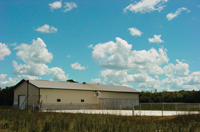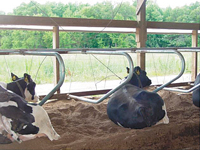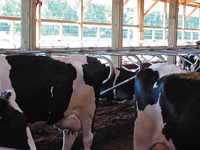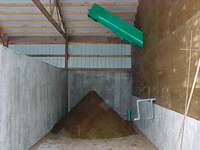
The Gordondale dairy farm in Wisconsin has found anaerobic digestion to be a good solution to overcoming phosphorus build-up in farmland, and it also delivers paybacks in power revenue and in providing some pretty comfortable bedding.
The Gordondale dairy farm in
Wisconsin has found anaerobic digestion to be a good solution to
overcoming phosphorus build-up in farmland, and it also delivers
paybacks in power revenue and in providing some pretty comfortable
bedding.
While the careful use of manure as an organic fertilizer on farmland is generally considered positive for both improving the nutrient value of soil and the bottom line for farm operations, excessive application can cause problems with nutrient build-up over time.
 An attraction for Gordondale farms was an open offer from the local power utility, which was looking for farmers interested in a pilot project that would use biogas produced from an anaerobic digester to power an electric generator. The dairy farm selected GHD Inc of Chilton, Wisconsin, as its anaerobic digestion system supplier. An attraction for Gordondale farms was an open offer from the local power utility, which was looking for farmers interested in a pilot project that would use biogas produced from an anaerobic digester to power an electric generator. The dairy farm selected GHD Inc of Chilton, Wisconsin, as its anaerobic digestion system supplier. |
That is exactly the challenge that intensive livestock operations like dairy farms and feedlots face with the build-up of phosphorus in farmland. Some producers—who make repeated demands on the same parcels of land to absorb large quantities of manure out of necessity—could end up with an unhealthy build-up of phosphorus. Also, excessive phosphorus build-up creates problems for manure hauling contractors who are forced to travel greater distances to apply manure to farmland.
With its investment in an anaerobic digester, one Wisconsin dairy farm believes it has discovered an option for intensive livestock operators to successfully deal with the problem of phosphorus build-up, along with delivering many more benefits to farm businesses, surrounding neighbors, and the environment.
“In the future, dairy businesses are going to have to handle the phosphorus issue,” says recently retired dairy farmer, Gale Gordon. “We’re kind of there already.” His observations are well founded.
In a publication produced by the University of Wisconsin— “Understanding Plant Nutrients: Soil and Applied Phosphorus,”—E E Schulte and K A Kelling write that based on 450,000 Wisconsin soil samples taken between 1982 and 1985, the level of phosphorus was “in the excessively high range.” The problem with phosphorus is that it occurs naturally in both an organic and inorganic state. When organic phosphorus in the form of fertilizer is applied to cropland, it quickly wants to convert to the inorganic or “fixed” form, thus leading to high phosphorus build-up over time.
“Anaerobic digestion offers an opportunity to influence the phosphorus in manure in that we are able to separate a lot of it out, and so hopefully we can apply it where soil tests dictate,” Gordon says.
Anaerobic digestion is essentially a process that excludes oxygen, where naturally occurring bacteria break down the manure over time into less toxic and valuable gas, liquid, and solid byproducts.
Gale Gordon’s son Kyle now owns Gordondale Farms, which is about 12 miles east of Stevens Point in central Wisconsin. However, Gale continues to monitor the performance of the dairy’s anaerobic digester and was directly involved in its installation three years ago.
“Most of the phosphorus in manure is tied up in the fibre,” he says. “Fibre only makes up about three percent of the bedding material that we get from the digested manure, so we get rid of a bunch of the phosphorus right there.” He says it is even possible with the addition of another step in the separation process to contain that remaining three percent by using a more sophisticated system to get the finer particles of fibre.
He adds that both federal and state authorities have been “very impressed and very supportive,” of the investment that Gordondale Farms has made into anaerobic digestion technology. The digester has become a focal point for scientific study as researchers measure output of the many byproducts generated by the digestion process.
The Gordondale Farms digester has also attracted a lot of national and international attention. Individuals from many regions of the United States and from as far away as Germany and New Zealand have toured the facility.
Gordondale Farms is the largest dairy operation in Portage County, milking 800 cows, and plans to expand its herd by another 300 head. The Gordons decided to invest in an anaerobic digester when they relocated their dairy barn further away from a neighboring village and trout stream. Kyle traveled the country looking at various options for managing their manure and determined that anaerobic digestion was far and away the best option. What sealed the deal was an open offer from the local power utility,
Alliant Energy, looking for any farmers interested in joining the company in a
pilot project that would use biogas produced from an anaerobic digester to power an electric generator. “So when that came along, we felt it would be a good idea to have somebody alongside us in a new venture like this,” says Gordon.
The dairy farm selected GHD Inc of Chilton, Wisconsin, as its anaerobic digestion system supplier. “Steve Dvorak from GHD had a lot of good ideas, a lot of answers and experience,” says Gordon. “So, after visiting with him a few times, it was pretty obvious that we’d be able to work very well with him. So we went with GHD.”
The manure transport system at Gordondale Farms consists of a two-foot flush flume pipe that delivers a slurry consisting of manure and wash water from the milking system and foot baths to the below-ground, concrete, anaerobic digestion tank. One aspect of GHD’s patented design is that it allows for flexibility in percentage of solids directed to the digester.
   Solids are de-watered to about 35 percent solid content and are used as free stall bedding in the dairy farm. “The main payback to the dairy farmer is the bedding,” says Gale Gordon. “We are able to provide bedding for all our free stalls and have a little excess.” Solids are de-watered to about 35 percent solid content and are used as free stall bedding in the dairy farm. “The main payback to the dairy farmer is the bedding,” says Gale Gordon. “We are able to provide bedding for all our free stalls and have a little excess.”
|
The slurry in the anaerobic tank is agitated at a scientifically determined rate to initiate, maintain, and accelerate the digestion process. The biogas produced within the first two stages of the digestion vessel consists of between 55 and 70 percent methane gas and is transported and burned as fuel for Alliant Energy’s 140 kilowatt electric generator. In the case of the Gordondale Farms installation, Alliant Energy owns the generator and switchgear. It pays the dairy farm for its biogas. The utility estimates that the manure produced by five to six cows delivers enough biogas to generate one kilowatt of power.
Gordon advises anyone interested in duplicating the Gordondale Farms’ system to consider owning and operating the electric generator themselves, then selling the power to the utility. They intend to do exactly that because by operating the generator themselves, the utility will pay them six cents per kilowatt generated. This revenue will help to bring the system in line to pay for itself in six years. A ballpark estimate of $500,000 to install an anaerobic digestion system wouldn’t be out of line, Gordon says, although it really depends on the size of the operation.
Anaerobic digestion takes place over a three-week, continuous retention time, and after the bacteria have completed their work, the digester effluent is then pumped into a manure solids separator.
It separates the effluent into solid and liquid streams. The solids are de-watered to about 35 percent solid content and can be used successfully as free stall bedding in the dairy farm operation.
Heat produced from the biogas generator is used to heat Gordondale Farms’ state-of-the-art barn, office and milk house, along with heating wash water. As part of the GHD system, waste heat in the form of hot water is collected from both the generator engine jacket liquid cooling system and the engine exhaust system. Between 30 and 60 percent of this waste heat is directed to the anaerobic digestion system. The remaining hot water can be used by the farm in its day-to-day operations and for in-floor heating.
The anaerobic digestion process delivers a number of benefits to the solid and liquid byproducts. These are the destruction of pathogens, weed seeds, and fly larvae, as well as the near elimination of odor.
“The main payback to the dairy farmer is the bedding,” says Gordon. “We are able to provide bedding for all our free stalls and have a little excess.” Gordondale Farms sells about 50 tons of bedding per month to other dairy farms and Gale says that anyone who has had an opportunity to try the bedding has indicated that the cows like it. Not only does it make comfortable bedding, the dairy farm saves money by no longer having to purchase cow mattresses for its free stalls.
Furthermore, the bedding can be recycled. Once manure builds up again, a skid steer equipped with a front-end loader attachment simply feeds the bedding into the flush flume system, taking it back through the digester.
A portion of the solid material is used as crop fertilizer. With a pH of about 7.8 versus 6.8 for raw manure, it is a much more neutral product requiring less investment in lime as a soil treatment. “If you want to spread it right on top of the crops, it won’t burn,” says Gordon.
Because the anaerobic digestion process kills weed seeds, there are further savings in reduced herbicide use. The liquid stream is collected in a lagoon at Gordondale Farms and is eventually spread on cropland along with some of the solid fertilizer. Some farms may choose to use the liquid stream as a water supply to irrigate cropland.
The dairy farm has few worries about adapting the system as it expands its operation. Gordon says the GHD design lends itself to expansion because all its pumps and equipment are situated at one end of the digester. “So you can expand the other end of the horseshoe loop and make it bigger,” he says. “You just add to the size of the pit. You don’t have to change the controls.”
Gordon concludes that this type of technology has an important role to play in agriculture’s future. “I believe it is a critical link between production agriculture and our environmentally sensitive society,” he says.